Building Carbon-Rich Soils the (Very) Old-Fashioned Way with Biochar!
Are you kidding me? Did Woodrow Call really pack Gus McCrae’s casket full of charcoal in order to carry his remains by wagon from Montana to Texas? So claims Larry McMurtry in his novel, Lonesome Dove. So there you have it, the 55th use for biochar (more on that later).
Bizarre as that sounds, it’s a fine concept and I’m sure one that worked quite well for Woodrow. Charcoal is an excellent choice for capturing and holding odorous gases ((important for not attracting bears and wolves in this case), liquids (not going there re the casket), heavy metals and toxins. And in burying old Gus, they were doing the soil a big favor, adding carbon that’s going to break down so slowly it can be considered true carbon sequestration.
Charcoal is mostly carbon, has great porosity and thus incredible surface area. A single cubic centimeter has 1000’s of square meters of surface area. All the better for adsorbing (picking up and holding) all kinds of things.[1]
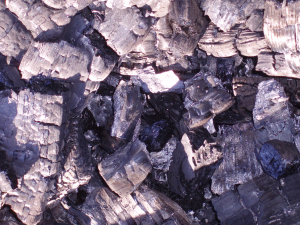 Enter biochar, charcoal that’s made with the express purpose of boosting or protecting soil biology and sequestering carbon. Adding biochar to soil tends to increase productivity, along with many other benefits. Biochar can be made with any clean, relatively dry waste biomass, like woody yard debris, slash from forest thinning and agricultural waste that’s too coarse for composting. Biochar can be made in pits, cone kilns, high-tech ovens, double-barrel stoves, in piles or even in a container in your woodstove.
Enter biochar, charcoal that’s made with the express purpose of boosting or protecting soil biology and sequestering carbon. Adding biochar to soil tends to increase productivity, along with many other benefits. Biochar can be made with any clean, relatively dry waste biomass, like woody yard debris, slash from forest thinning and agricultural waste that’s too coarse for composting. Biochar can be made in pits, cone kilns, high-tech ovens, double-barrel stoves, in piles or even in a container in your woodstove.
Biochar can exhibit many different characteristics depending on the feedstock, the technique used to make it, the temperature at which it’s made, the length of time it’s exposed to heat, the cooling and aging, and what, if any, elements you add to ‘charge’ it. The delight of playing with biochar is that you can get as simple or as scientifically technical as you want. Once you understand a few simple things about biochar, you’re good to go and so is your soil.
The added benefit to biochar in this day and age is the extensive research and experimentation that’s been done in the public, academic and private sectors. A quick online search for “biochar surface area” yielded over 500 results from the USDA’s Agricultural Research Service alone. The plethora of biochar websites and online videos could keep you busy reading and watching for years.
Two past issues of Permaculture Design (formerly Permaculture Activist) had excellent, in-depth articles about biochar.[2],[3] The one entitled “55 Uses of Biochar”[4] by Hans-Peter Schmidt and Kelpie Wilson actually identified 54 uses and challenged us readers to find the 55th. I say McCrae’s casket-packing qualifies!
Biochar seems mysterious but once you understand what it is and how it functions from a permaculture and soil-building perspective, this comprehensive but simplistic article will equip you with enough information to confidently start experimenting with biochar. Then you can go exploring for more – the creativity, insights, and experience of biochar enthusiasts and researchers from around the world will engage and inspire anyone who loves hands-on soil building.
WHAT IS BIOCHAR REALLY?
Technically, biochar is a highly porous, fine-grained form of charcoal, resulting from thermally converting woody biomass in a limited oxygen environment. It’s made specifically for pro-biological use and carbon benefits versus energy. Biochar is a bio-mimetic addition to soil, following nature’s pattern of soil building in grasslands and forests.
Why not just call biochar ‘charcoal’? The difference is its intended use – charcoal is about using densified carbon for energy or filtration; biochar is about saving the carbon to help protect and enhance biological functions, particularly in soil. Biochar can be used for filtration and remediation and still be called biochar if the actions focus on protecting life in terrestrial and aquatic settings.
 Since humans discovered fire, we’ve been making charcoal, primarily to concentrate energy by reducing woody biomass to its carbon content by ‘baking’ it, typically allowing it to smolder — and produce a lot of smoke. Charcoal-makers ‘bake’ the feedstock in a container, kiln, pit or covered pile so the amount of oxygen exposure can be controlled, just like biochar-makers, except we aim to do it without smoke. Restricting oxygen and terminating the heat at maximum charring means much of the carbon component remains instead of turning to ash. The resulting lumps of carbon provide concentrated, transportable energy. Charcoal remains a critical heat source for cooking (and an economic driver for rural communities) around the world. When making biochar, you follow the same principles but you ensure your feedstock and your burn practices are clean (not smoky!). Do not use modern charcoal made for grilling or heat as biochar as it may contain accelerants or other contaminants.
Since humans discovered fire, we’ve been making charcoal, primarily to concentrate energy by reducing woody biomass to its carbon content by ‘baking’ it, typically allowing it to smolder — and produce a lot of smoke. Charcoal-makers ‘bake’ the feedstock in a container, kiln, pit or covered pile so the amount of oxygen exposure can be controlled, just like biochar-makers, except we aim to do it without smoke. Restricting oxygen and terminating the heat at maximum charring means much of the carbon component remains instead of turning to ash. The resulting lumps of carbon provide concentrated, transportable energy. Charcoal remains a critical heat source for cooking (and an economic driver for rural communities) around the world. When making biochar, you follow the same principles but you ensure your feedstock and your burn practices are clean (not smoky!). Do not use modern charcoal made for grilling or heat as biochar as it may contain accelerants or other contaminants.
NATURE’S BIOCHAR
Wildfires, as scary as they can be, are vital to building soil. Charcoal left after a fire becomes part of the soil profile. The rich, black soils of the Great Plains exemplify this amazing artifact of repeated fire. A prairie fire turns grass blades to ash, but the denser crowns of the grasses char. Over eons, that charcoal, with the help of grazing buffalo, has permeated and enriched the soil providing the most fertile and productive soils in the United States.
Early indigenous people learned that soils enhanced with charcoal produced more and better food and wildlife habitat. In temperate climates where wildfires regularly burned, nature was already supplying the biochar. Humans copied nature in setting fires because of its myriad benefits but no apparent evidence suggests that in temperate climates, humans purposely added biochar to soils. But in tropical and humid climates, wildfires are rare. Significant evidence shows that indigenous people, over 2500 years ago, were regularly and purposefully adding biochar to soil. Likely through their land clearing and burning for agricultural purposes, Amazonian natives deduced that where they burned debris produced more crops.[5]
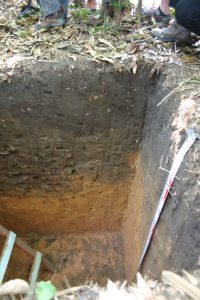
Soil pit in Amazon showing depth of biochar additions
Amazonian residents created large nodes of black soil (terra preta) in the otherwise orange, iron-rich, nutrient-poor jungle soils. The productivity of terra preta soils exceeds adjacent unenhanced jungle soils by a factor of five! And the amazing thing is, those soils are STILL five times more productive, thousands of years later. A well-researched article on terra preta, found in Wikipedia, summarizes it succinctly.
“Terra preta is characterized by the presence of low-temperature charcoal in high concentrations; of high quantities of pottery shards; of organic matter such as plant residues, animal feces, fish and animal bones and other material; and of nutrients such as nitrogen (N), phosphorus (P), calcium (Ca), zinc (Zn), manganese (Mn). It also shows high levels of micro-organic activities and other specific characteristics within its particular ecosystem. It is less prone to nutrient leaching, which is a major problem in most rain forests.”[6]
Interestingly, research today continues to confirm that the poorer the soils, the greater the positive impact of biochar. Yet, even on the best-of-the-best soils in the Midwest, biochar can have a positive impact. The USDA Agricultural Research Service conducted a biochar study on three grades of what are considered the best soils in the U.S. There was some minor productivity improvement on the ‘good’ and ‘better’ soils but nothing notable on the ‘best’… until a drought. All biochar amended sites showed marked improved productivity and resilience during water-stress in comparison to control plots.
KEY POINTS IF YOU’RE IN A HURRY
If you don’t have time to read this whole article, here are three points about biochar that you need to know.
All biochars are not alike. Their key characteristics – which affect their performance – vary based on the feedstock used, the temperature at which they’re made, the length of time they are “baked” (called time-in-residence), and how they are handled after “baking.” Biochars made from softwoods like conifers, tend to be easier to crush and have higher porosity. Biochar made through pyrolysis (high temperature kilns with no oxygen), tend to be higher in pH, finer grained and similar to a thoroughbred horse, a little more challenging to handle for the novice. Low temperature biochar may still retain a smoky smell meaning all the volatile organic compounds have not been burned away. Some biochars may not be fully quenched after making or not be exposed to air and rain, which help oxidize (activate) the surfaces.
Despite these differences, all biochars made from clean biomass can be highly functional. Buying your biochar from a professional with a tested product or learning about/making biochar yourself can help you select the right char for your intended use.
Always use clean, dry, uncontaminated feedstock. Ideally your feedstock will contain 10-15% moisture. More than that and a lot of your heat is spent evaporating excess moisture and creating smoky steam. Biochar-makers want to use the smoke (carbon monoxide, methane, hydrogen… they all burn) for added heat vs. pollution.
Some elements in the biomass you use will disappear in the charring process, but others will not. If you want to add a boost of calcium and phosphorous to your soil, you can char bones. For winter fun, pressure cook bones from a butcher and use the broth and scraps as dog or chicken food. Then put the bones in a stainless restaurant steam table pan, place that on the top of the woodstove to dry out the bones, then pop a lid on (snug but not tight fitting) and put the container in the wood stove for 24 hours. Crunch them up and spread them in your garden.
Don’t be tempted to add other waste to your charring operation – cardboard, trash, particle board, pressure treated wood – no matter how minimal. For example, whereas pressure treated wood has improved in recent years by reduced toxicity through contact, those toxins are released when cutting or burning. The green-tinted preserved wood is called CCA because it contains copper, chromium and arsenic. Copper is an important trace element for soils but chromium and arsenic can be highly toxic, even fatal, to humans, birds, plants and animals. Burning releases some of those toxins into the air, the rest is retained in the ash and char. Even if the preserved wood only makes up 5% of the burn pile, chromium and arsenic are still found in levels high enough to qualify the whole pile as hazardous waste.[7]
In raw form, biochar is not a fertilizer, it’s a soil amendment. Biochar, fresh out of the kiln, or however it’s made, is a clean, raw product. Its surface area, particularly when rinsed, is highly active and open for business. Adding fertilizers or nutrients is called “charging.” Uncharged biochar has many uses but adding uncharged biochar to your garden soil can actually slow growth until the biochar stops pulling in nutrients and starts to release them. If you’re looking for biochar for reclamation or want to add your own fertilizer, buy raw biochar or make your own. Then add compost or manure tea, urine or, even easier, put biochar in your compost pile!
HOW BIOCHAR FUNCTIONS
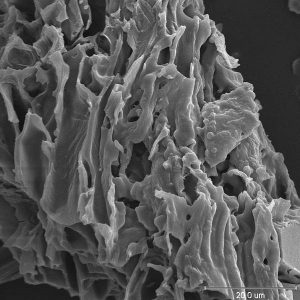
Biochar has tremendous surface area
Biochar performs all of its seemingly overstated functions because of its physical and molecular structure. Biochar’s oxidized surfaces have a negative charge so they attract and loosely hold elements with positive charges like water, nutrients and greenhouse gases (methane, nitrous oxide and carbon dioxide in particular). Additionally, research strongly suggests that since biochar can hold 5-6 times its weight in water, biochar adds 23-30% more water-holding capacity in soils thus reducing irrigation needs and moisture-stress on plants.[8]
Biochar has a high porosity, meaning it has a plethora of little pores and pockets reflecting the cellular structure of the original feedstock after the water and gases are driven out by high heat. Different processing temperatures change the pore structure and cellular organization of biochar.[9] These pores make great habitat for microbes, bacteria and mycelia. And that’s very important. It gives these little life-enhancing species protection from predators or physical displacement by rain and a moist, nutrient-rich environment.
Besides being a condo for tiny soil builders, biochar functions like a trading post. Plant root hairs wrap themselves around
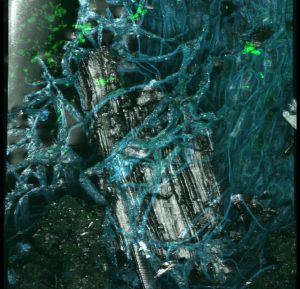
Root hairs wrapped around biochar particle
biochar particles while the biochar pore-dwellers bring minerals and nutrients to roots in exchange for the sugars and carbohydrates from plant photosynthesis. Roots quickly “learn” to seek out biochar.
The electro-chemical actions of biochar pull in soil greenhouse gases and holds them for at least three years – that’s as long as research has tracked this phenomenon. It’s quite likely it holds those gases for considerably longer. Studies have demonstrated up to 80% reductions in nitrous oxide (N2O) off-gassing from soil amended by biochar. Biochar not only reduces damaging N2O[10] but also holds the nitrogen in place where it can be used by plants and soil biota.
Why is holding nutrients stable in soil so important? Fertilizer run-off, particularly nitrogen and phosphorous, poses a major environmental problem. Whether chemical or organic, nitrogen and phosphorous (a non-renewable resource) tends to either off-gas (N2O) or travel through soil to surface water. The nutrient-enriched water exacerbates algae growth which depletes oxygen needed by aquatic species, thus suffocating them. These errant nutrients move downstream until reaching the ocean creating the extensive ocean dead-zones – larger than some states – tragically found at the mouths of rivers around the world.
Case in point. Nutrient loading in the Chesapeake Bay nearly destroyed much marine life, including the life-blood of many local communities – crabs. Recent progress on slowing that trend came about in large part due to an extensive nutrient-regulatory system for agriculture throughout all the headwaters, with strict limits per farm or ranch.
Biochar holds those traveling nutrients in place, helping keep streams alive, while allowing plants – the intended recipients – to uptake those nutrients. That means less applications of fertilizer. That’s particularly beneficial to the planet if those fertilizers are made from fossil fuels and mined resources and spread by fossil-fuel burning equipment. For those of us fertilizing with beneficial organics, that means greater efficacy and a few less wheelbarrow loads of work!
The moisture-holding boost from biochar speaks for itself: less water, less work for the same results. The California Department of Agriculture is keenly interested in biochar to help the ag industry reduce water consumption through repeated droughts and slow the depletion of hydrologic systems.
PUTTING THE BIO BACK IN THE CHAR
Permaculture and biochar are so compatible![11] Biochar shines as an example of stacking functions and inserting key elements at specific locations and times to leverage greater results throughout the system. Biochar in the garden builds soil through a chain of mechanisms, direct and indirect, while performing a few other neat tricks, there and on the way to the garden.
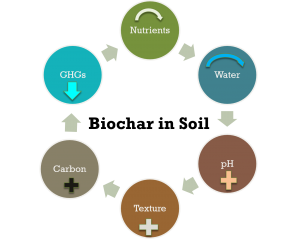 Directly, biochar delivers the nutrients that charged it as well as attracting and holding existing nutrients (with gentle covalent bonds so they are bioavailable). If your soil already is well-nourished, biochar adds to the party. If your soil needs help, charged biochar can move it to the next level.
Directly, biochar delivers the nutrients that charged it as well as attracting and holding existing nutrients (with gentle covalent bonds so they are bioavailable). If your soil already is well-nourished, biochar adds to the party. If your soil needs help, charged biochar can move it to the next level.
Biochar’s physical structure and long-lasting carbon can hold more moisture in sandy soils. Biochar adds tilth (fluffiness) to clay soils by propping open pore spaces which would otherwise collapse into hardpan when dry. Likewise, biochar allows for greater gas exchange and oxygen movement through soils, benefitting all the living creatures.
Biochar typically attracts mycelia and microorganisms. Essential to living soil health, these creatures, along with worms, help to build soil. But a caveat, some biochar can temporarily negatively affect earthworms, depending on feedstock, soil type and the biochar’s pH. Test your biochar before applying to a large area by adding your biochar to one end of a wide container of your soil and earthworms in the middle. You’ll be able to assess, in a couple of days, whether the worms are in the biochar end or have moved away from it. The International Biochar Initiative (IBI) provides an easy-to-follow guide to conducting worm avoidance tests which can be found online.[12]
Research continues to evolve on earthworm/biochar relationships but is complicated by the many variables in soils, worm species and specific attributes of the biochar. Anecdotally, glowing reports about the compatibility of biochar and worms abound, but anecdotes don’t substitute for research. If in doubt, conduct your own experiments – only you have access to your unique combination of biochar, soil, amendments and worms!
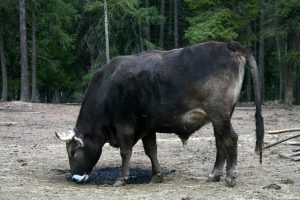
Hercules enjoying a biochar snack
Biochar can also get to your soil via a more circuitous route of stacked functions. Feeding livestock and poultry biochar (1% of their feed by volume) has many benefits: removal of internal toxins, neutralizing and cooling the digestive system, reducing methane off-gassing (belching and passing gas) by 50% in ruminants, and for poultry, also adding necessary grit to their system. When the creatures drop manure, it’s already enhanced with biochar.
Adding biochar to stalls, coops and animal bedding reduces odors and flies while soaking up excess moisture and nutrients. I can easily go all winter without cleaning out the chicken coop for my 20+ chickens – just sprinkle biochar over each new application of straw and your flock will enjoy clean air and charcoal snacks. Cleaning out the coop in the spring is a breeze: loose, dry, heavily-pooped litter that doesn’t smell. When you ‘harvest’ the barn and chicken coop litter to add to your compost or garden, there’s already charged biochar in there, ready to rock your garden.
WHERE TO GET BIOCHAR
Commercial biochar can be surprisingly easy to find, but perhaps confusing, once you locate sources. Containers of all sizes are available. Most sell by volume as weights can vary depending on feedstock and moisture content. You’ll have a series of choices to make. Primarily, do you want charged or uncharged biochar which differentiates between treated or untreated with any nutrients, ferments or minerals. Charged is convenient and usually companies pride themselves on the effectiveness of their proprietary additions to their char. The mystic is reminiscent of secrets of brewers of craft beer.
Keep in mind that shipping has a notable carbon footprint. Look for chars within your region. Although the nexus has never been investigated, it makes sense to mimic nature and select a biochar made with a feedstock that’s common in your area.
The key questions to learn about a commercial biochar are: what’s it made of, where is it from, has it been tested, what’s its pH and if it’s charged, what with, and its recommended uses? If you elect to use a commercial biochar, you might want to order a small quantity initially so you can determine how well it works for its intended use on your site.
Remediation, storm water treatment and shoreline restoration require uncharged biochar to allow for maximum adsorption of undesirable or toxic elements that contaminate soil. But you might prefer to get uncharged so you can add your own brew of healthy-soil ingredients. Charge your char with manure tea, compost tea, bokashi ferments, minerals, urine or, easiest of all, put it in your active compost pile. I like to start my compost with a layer of coarse char to capture any nutrients leaking down from above. I add more char in between layers aiming for 15% char by volume in the pile. Biochar in compost reduces off-gassing and odors, darkens the pile increasing radiant heat, and holds moisture evenly throughout the pile.
HOW TO MAKE BIOCHAR
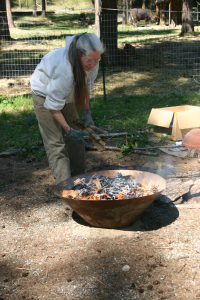
The author – a pyromaniac!
Want to have some fun? Try making your own biochar! It’s relatively easy once you get the hang of it. But like any other skill, repeated practice and keen observation will take you to a whole other level. Learn from your mistakes and you’re on your way.
That said, a plethora of biochar-making techniques exist. The best one is the one that works best for you and your circumstances – your skills, your resources, your needs. Particularly desirable are those techniques where you can also capture and use the heat (energy) from the burn, again stacking functions. Thompson Timber in Philomath, OR has a biochar kiln built of recycled materials by biochar expert, John Miedema. Thompson turns their debris into biochar, uses the heat from biochar-making to dry their lumber, then uses the biochar in their growing medium in their tree nursery. No waste, less electricity, less vermiculite and healthier seedlings. The problem (excess biomass waste) became the solution to reducing several other costly inputs into their system.
Three primary biochar production methods, with tons of variations on the themes, exist: closed container, semi-open container and open. Remember your feedstock needs to be free of contaminants and have a low moisture content (10-15% is ideal).
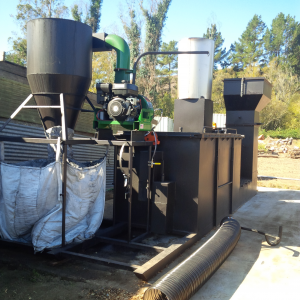
A high-tech Adam Retort Biochar Oven built by Northeast Biochar.
Closed containers can range from high-tech automated pyrolysis ovens to masonry units to snazzy two-barrel set-ups with fancy vent systems to small, lidded containers you place in a larger burn device. The key point is that oxygen is very restricted by the container. The more technologically advanced systems tend to be stationary units, can be quite costly and require a high level of operator skill. Low-tech containers can be inexpensive, mobile and reasonably easy to operate. Container methods need specifically sized feedstock, but tend to release less gases and can attain very high temperatures. The carbon recovery is highest of all methods (percent by volume of biochar compared to the feedstock volume).
Semi-open containers are represented by pits, cone kilns, troughs, Kon-Tiki kilns, etc. These units can be made or purchased. Although more oxygen is available to the biomass, these methods allow for greater flexibility in type and size of feedstock and are more forgiving of operator error. Unit size can vary from very small to many feet across. Most are relatively mobile so they can be moved to the feedstock source. Carbon recovery is moderate to high.
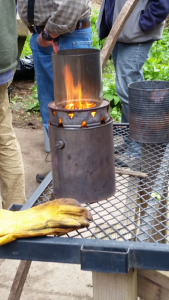
Homemade double-can burner
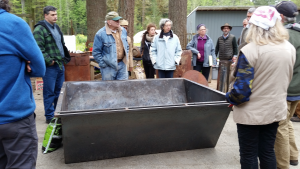
4’x8′ Trough Burner fits in the back of a pick-up truck.
Open method is simply burning material without containment. Piles require about a 50-50 ratio of space to material. Materials are best at <3” diameter with a well-graded mix of smaller sizes. Fines should be no more than 20% of the pile. Oxygen can only be slightly limited. Conservation, top-lit or flame-cap burning, as these open methods are called, requires that the pile be top-lit[13] to minimize smoke and maximize biochar production, which will be notably less by volume than other methods. Open methods, while easy to set up, require vigilance and a skilled eye at recognizing when to start pulling char out of the fire and incrementally quench.
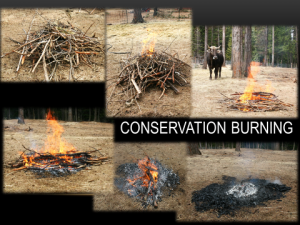
Sequence of top-lighting and retaining char in an open burn as Hercules looks on.
HOW TO TEST BIOCHAR
You can send your biochar to a lab specializing in biochar evaluation- which all commercial producers should do regularly. But you can also conduct some simple home tests to judge the general quality of your biochar. First and easiest is the smell test, if your biochar smells smoky, gases haven’t completely been burned off. This may or may not present problems – test further. If it really smells like you could extract liquid smoke from it, try re-heating it.
If after rubbing the biochar between your fingers, you need to use soap and water to wash it off, there are still oils in the biochar meaning it’s under-cooked. The oils could retard plant growth, but keep testing. Again, you can always reheat it – you’ll lose some char but better than putting marginal biochar in soils. No commercial biochar should be smelly or oily.
Now you’ll need to see how living organisms react to your biochar. As discussed above, there’s the worm avoidance test. In the same document[14] are instructions for a germination test. Simple, but effective, you’ll quickly see results.
To get a general idea of pH, you can put biochar in a small container and add some vinegar. Look and listen for the fizzing. The more boisterous the response, the higher pH you have which suggests a higher ash content. Ash can be helpful to some soils but it isn’t biochar carbon. You can use a soil test kit and get an actual reading. Usually, charging biochar through composting will neutralize the pH.
Field testing your biochar takes some time but will confirm biochar quality and effects. You can set up a simple test using guidance from the International Biochar Initiative[15]. You’ll find germination and worm avoidance test instructions here as well.
HOW TO APPLY BIOCHAR
We all dance around this question. Permaculture culture provides the best response: “It depends.” The high number of variables (feedstock material/source, elemental content, ash content, pH, production method, moisture content, soils…) makes it challenging to provide a definitive answer. The good news is that you will almost always have enough biochar to make a difference, but less than you want.
For the novice, applying compost with 10-15% biochar by volume is the most fool-proof method of soil-building in your garden. If you’re not composting, you can apply charged biochar directly to soil by broadcasting or mixing charged biochar directly into planting holes. Remember to conduct a few simple tests first. If satisfied, start with two cups per square foot. Work the biochar into the top several inches. Ultimately, you want biochar distributed throughout the root zone.
Uncharged biochar can be used as a light mulch or top-dressing, particularly if the pieces are rather large. When applying biochar, be aware that fine, dry biochar can be an irritant to eyes and respiratory systems: keep it damp or wear a mask and googles on a windless day.
Applying biochar to larger acreages can be done with a tractor, using seed drills or manure spreaders. As with hand application, keep the biochar damp. Surface application of biochar subjects it to wind and water erosion, so either till it in or apply mulch to hold it in place.
In field trials, most point to an ideal quantity of 10 tons of biochar per acre, tilled into the top 4-6”. That’s a lot of biochar! Adding that much biochar or any new material to soil can shock the soil system (although field trials at that level consistently seem to produce positive results even in the first year). Most practitioners recommend adding biochar incrementally up to that amount, as the natives likely did.
How much is too much? 60 tons per acre – if you even imagine that much – seems to be the limit of what most soils will accept without deleterious results.
You don’t need to apply biochar annually as it does not break down readily; it will typically last 100’s to 1000’s of years in the soil. We can guess that the biochar in terra preta soil (which can be found blackened with biochar to over 6’ deep) wasn’t applied all at once. Common sense suggests it would be easier on soil biota if biochar were applied incrementally over time.
Adding carbon in multiple forms is excellent for soil health. The soft organic matter of compost will last a year or so in recognizable physical form. The carbon in biochar will last for your lifetime and beyond. Your soil needs both, the planet needs both. The recent book, Drawdown, edited by Paul Hawken, evaluated and measured 81 techniques to reduce atmospheric carbon to combat climate change. Of course, biochar made the list! (Permies will laugh in delight to see so many of our favorite tools and management systems high on that list.) So while you’re building your soil, you’re setting climate change back a tick or two.
In summary, biochar is a biomimetic, carbon-negative path to soil enrichment. Biochar is accessible, scalable and egalitarian. Biochar turns waste into a valuable resource and building blocks for food and future trees. And I share with you my favorite biochar benediction which you will discover for yourself, “Biochar is really cool. And you get to play with matches.”
[Published in Permaculture Design Magazine, August/Fall 2018 Issue #108 www.permaculturedesignmagazine.com]
 Gloria Flora, among other things, is the director of Sustainable Obtainable Solutions and founder of the U.S. Biochar Initiative. She and her husband are building and nurturing TerraFlora Permaculture Learning Center in northeast Washington with TLC and biochar.
Gloria Flora, among other things, is the director of Sustainable Obtainable Solutions and founder of the U.S. Biochar Initiative. She and her husband are building and nurturing TerraFlora Permaculture Learning Center in northeast Washington with TLC and biochar.
Resources:
Just a brief sampling of where to get more information. My apologies to all the wonderful biocharians out there who are not mentioned below, heros and heroines for soil and carbon sequestration.
On-Line
U.S. Biochar Initiative – www.biochar-us.org, see Resources section for introductory information and the Go Deeper section for research. USBI hosts conferences around the U.S. almost every year.
International Biochar Initiative – www.biochar-international.org. Extensive information and 1000’s of research articles.
Backyard Biochar – www.BackyardBiochar.net. Website for sharing open source, low tech methods for sustainable biochar production and use from Kelpie Wilson.
David Yarrow – http://www.dyarrow.org/biochar/. An older site but chock-full of references, resources and wise advice.
Scholarworks – https://scholarworks.umass.edu/biochar/ A repository of conference papers from the 2013 USBI Conference in Amherst Massachusetts.
Facebook – do a search for Biochar Groups, Pages and posts. You’ll be busy for a long time…
YouTube – At 50,800 videos keyworded to biochar, you’ll need to be specific in your search!
Books
The Biochar Solution: Carbon Farming and Climate Change by Albert Bates, New Society Publishers. 2010
Terra Preta: How the World’s Most Fertile Soil Can Help Reverse Climate Change and Reduce World Hunger by Ute Scheub, H. Pieplow, H-P. Schmidt, K. Draper, Greystone Books. 2016
Sacred Soil: Biochar and Regeneration of the Earth by Robert Tindall, F. Apffel-Marglin, D. Shearer. North Atlantic Books. 2017
[1] Absorbing means one element soaks up another to create a new product, like mixing milk with cocoa. Once it’s chocolate milk, you can’t go back to either plain milk or cocoa. A sponge demonstrates adsorption; it picks up and holds liquid but will release it with a good squeeze and both the liquid and sponge will go back to what they were doing before you came along.
[2] Wilson, K., Schmidt, H-P., Biochar—the Carbon Kickstarter: Supercompost to the Rescue!. Permaculture Activist, pgs. 19-25, Issue No. 93: Experimentation – Science in Permaculture. August 2014.
[3] Schmidt, H-P., Wilson, K., 55 Uses of Biochar – A Great Chain of Benefits. Permaculture Activist, pgs. 9-12, Issue No. 92: Stacking Functions. May 2014
[4] https://www.biochar-journal.org/en/ct/2-The-55-uses-of-biochar
[5] In my biochar classes, participants relate similar experiences. Alfalfa growing thrice the height in mysterious, regularly spaced circles throughout a field spurred some research. Turns out the site was a former orchard and when the old trees were cleared, they were burned in piles throughout the field. Likewise, the long windrows burned in a land-clearing operation, decades later, caused a 3-fold increase in barley production in those rows compared to the rest of the field.
[6] Glaser, Bruno., et. al. “The ‘Terra Preta’ phenomenon: a model for sustainable agriculture in the humid tropics.” Naturwissenschaften 88, 37–41 (doi:10.1007/s001140000193). 2001. Cited in https://en.wikipedia.org/wiki/Terra_preta#cite_note-glaser01-31
[7] Solo-Gabriel, H.M., et al., Characteristics of chromated copper arsenate-treated wood ash. Journal of Hazardous Materials, B89 (2002) 213–232. Found at http://www.ccaresearch.org/CCA_Ash_Paper.pdf
[8] Basso, A. S., et.al. (2013), Assessing potential of biochar for increasing water‐holding capacity of sandy soils. GCB Bioenergy, 5: 132-143. doi:10.1111/gcbb.12026
[9] McLaughlin, H., Shields, F. Analytical Options for Biochar Adsorption and Surface Area. 2012. Found at http://www.micromeritics.com/Pressroom/Press-Release-List/A-Technical-Paper-Highlighting-Analytical-Options-for-Biochar-Adsorption-and-Surface-Area-was-Recently-Presented-at-the-2012-Biochar-Conference.aspx
[10] Nitrous oxide has an average Global Warming Potential 280 times more impactive than carbon dioxide.
[11] See sidebar – Biochar in Permaculture Principles
[12] IBI Technical Bulletin #101; Quick tests to determine whether a biochar material contains compounds that are potentially harmful to plants. Found at: http://www.biocharinternational.org/sites/default/files/Technical_bulletin_101_english.pdf
[13] Top lighting heats the material below the flame, allowing gases to vaporize. The heat draws in the gases (which dissipate as smoke if bottom lit) and combusts them.
[14] See footnote 10.
[15] http://www.biochar-international.org/sites/default/files/IBI%20Simple%20Guide-english.pdf
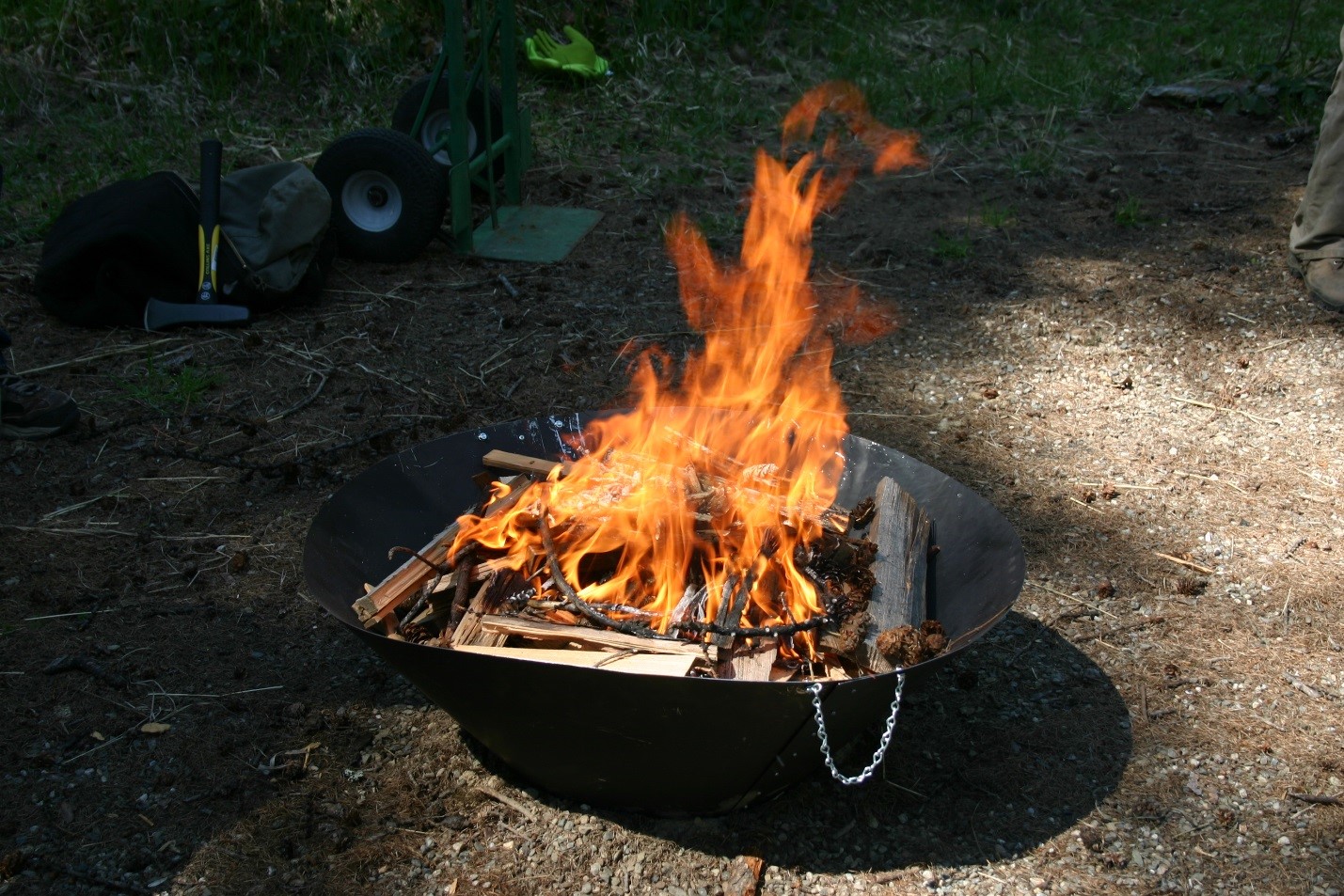
The story about Call dragging Gus’s body back to Texas was loosely based on a real event….which was Charlie Goodnight ( who was a real Texas Ranger, among other things) bringing Oliver Loving’s body back to Weatherford Texas from Ft. Sumner New Mexico, where he died of gangrene after being wounded in an Indian attack. Loving’s wooden casket was packed with charcoal and placed inside another sarcophagus made out of tin, handmade from oil cans beaten flat and soldered together. It rode in a big wagon Goodnight had built for that single purpose, pulled by six mules, and it was accompanied by a group of cowboys and a chuck wagon (Goodnight invented the chuckwagon).
So it was a real use of biochar. And it actually happened.
Central Texas during the mid 19th century was known for producing charcoal from the invasive Ash Juniper that still grow everywhere here…..it is said that the whole region was smoky at times from the banked fires of the “cedar choppers”……fyi.
WooHoo! Eddie, can’t thank you enough for this verification! I’ll credit you for identifying the legitimate 55th use of biochar. I just sent your comment to the authors of the original article identifying 54 uses and challenging the reader to find a 55th! A toast to you and that luscious bit of history. A DDS and PDC? – love it. Thanks for reading our blog.
Hi, I think your blog might be having browser compatibility issues. When I look at your blog in Safari, it looks fine but when opening in Internet Explorer, it has some overlapping. I just wanted to give you a quick heads up! Other then that, awesome blog!| а
Thank you! I’ll see what we can do about that, sounds annoying. I use Opera primarily so didn’t notice. And glad you like our blog! Stay tuned, I have several more articles to post.